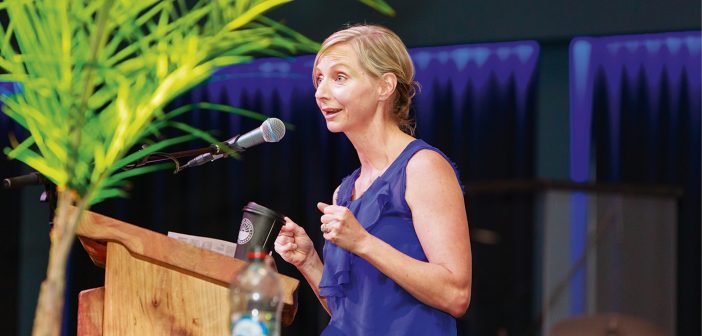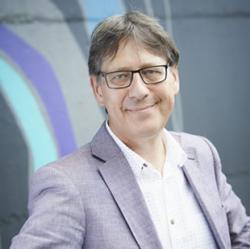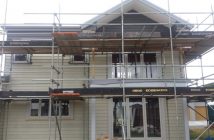I attended a Pecha Kucha evening at the recent Cambridge Autumn Festival.
A good crowd of expectant people – as ever entertained by the intelligent whimsy of MC Dr Richard Swainson – was treated to 10 tight talks ranging from Josh Easby’s ‘A lifelong love of Football’ centring on the luckless York City FC team, to Camille Guzwell’s recovery journey having suffered concussion in a football game at, by chance, Easby’s current pitch in Cambridge.
Of note on the night however, was a coincidence of subject focus that may have once seemed fringe, but now takes central stage as being essential and immediate issues. Presentations on collective action in community gardening, co-housing, and minimising one’s negative impact upon the environment were direct and compelling.
Hamiltonian Rebecca Brown spoke of the restorative and meaningful nature and culture of the Kukutaruhe community garden adjacent to Fairfield College; of having a garden plot alongside others, and sharing knowledge of working with the land and seasons to nurture and grow vegetables for her family table. Rebecca was up-front how the fellowship of the Kukutaruhe gardeners and a ‘place to call one’s own’ provided a productive sanctuary for someone who lives in an era where owning your own home is an uncertain dream.
Brad White, a passionate advocate for co-housing, talked of the journey he and a group of families and individuals have undertaken over the last couple of years. Brad explained co-housing (CoHo) is an international movement that sees people form what seem like ‘mini-villages’ comprising an enclave of houses (with vehicles kept at the edge), good outdoor space and gardens, some shared facilities and some shared decisions. The benefits he described included a more affordable home ownership model, better utilisation of land, infrastructure and buildings, and a sense of neighbourly connectedness and purpose. A difficulty is in finding land of suitable size and sufficiently close to Cambridge township for the advantage that urban living and working provide. Brad announced that ‘making contact through the old-fashioned medium of a letterbox drop’, discussions are now underway with a landowner for a potential site purchase.
After a corporate career in fast-moving consumer goods, Nic Turner demonstrated with examples in her own life that consciously making many small decisions on a daily basis becomes an easy habit and way of life for consuming, discarding and spending much, much less. The impact is a smaller lifestyle carbon footprint and virtually no waste; Nic’s family throws out just a single bag of rubbish every year. The clarity, simplicity and result of the endeavour is startling.
The coinciding focus of these talks – along with some of the other presentations at the Cambridge Pecha Kucha – is on a care for, and connection with, the things around us – the planet, community and the neighbourhood – and on a capability and imperative to work together. Each talk expressed an active rebalancing of lifestyle values. In some ways, this consideration reflects the slower, more conscious and more resourceful way that most of us had to, or chose to, live through last year’s seven-week lockdown.
So what of architecture and urban design in all this conscious rebalancing?
Not to overdo coincidence, and moving from a local to a global perspective, in mid-March the 2021 Pritzker Prize for Architecture was awarded to French architects Anne Lacaton and Jean-Phillipe Vassal. The Pritzker Prize is architecture’s greatest professional accolade, honouring a living architect or architects whose built work demonstrates a significant contribution to humanity and the built environment. Past recipients include American Frank Gehry, Australian Glenn Murcott, and the late, London-based Iraqi architect, Zaha Hadid. This year’s award is a radical departure in that Lacaton-Vassal is not known as a ‘star-architect’ with its own brand of new architecture.
The Pritzker Award jury noted that – as architects of urban housing, private residences, schools and galleries – Anne Lacaton and Jean-Phillipe Vassal in their 33 year practice have ‘consistently expanded the notion of sustainability as a real balance between its economic, environmental and social pillars’. Lacaton and Vassal have a reported mantra of ‘Never demolish, never remove or replace; always add, transform and re-use’. Their architectural projects are premised on adding to and enhancing the attributes of an existing building and surrounds rather than the prevalent and often expedient approach of demolition and rebuilding anew. Given that the built environment currently accounts for an estimated 40 percent of global carbon emissions, this approach to development acknowledges the inherent architectural worth, the considerable quantity of local and imported materials, and the substantial amount of energy invested at the outset in the construction of every building.
Here in Hamilton, we have seen this approach with Stark Property’s redevelopment work, building on the foundations and framework of existing and perhaps tired old buildings, and reinvigorating the inside and outside visage with new life.
This year’s Pritzker Award acknowledges a timely re-balancing of the development paradigm, and recognises that a concerted, sustainable approach to design and development is required. The challenge remains in seeking to consider many other older Waikato properties and their character in the face of seismic strengthening, increasing floor space, and quality requirements.





